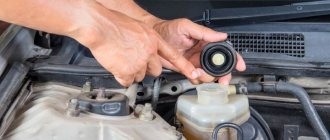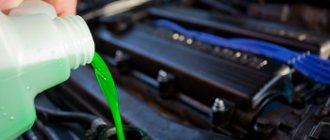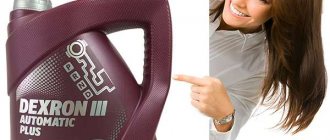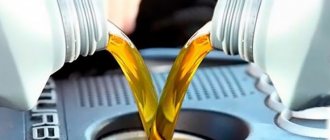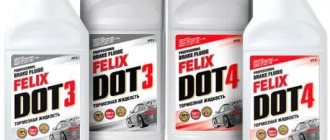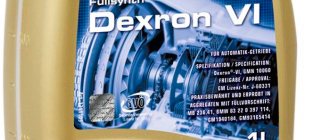Is it possible to mix them
Mixing liquids is the most pressing issue that can stump even professionals. The manufacturer itself recommends adding another type of liquid to the existing one, if this is allowed by the technical conditions of the box itself. For example:
- mixing types IID (mineral water) and IIE (synthetic) causes a reaction with precipitation. There is a loss of liquid properties. What is fatal (deadly) for an automatic transmission;
- mixing mineral bases IID and III Dextrons is allowed, provided that the liquid from the same manufacturer or additives from different manufacturers do not conflict with each other. Otherwise, the properties will deteriorate, which is harmful for automatic transmission parts. The differences between Dextron 2 and Dextron 3 are in their properties and additives. The use or addition of a newer modification is permissible if the base and manufacturer match.
With complete replacement
It would be smarter and safer to perform a complete fluid change, without the risk of incorrect mixing, but is this always possible:
- Replacing IID with IIE is allowed for any type of box. Their properties are almost identical, so there will be no harm;
- replacing IIE with IID is not recommended, since the liquid of the previous generation may not cope with the requirements of the box for the next generation liquid;
- modification III is allowed to be used in boxes where II was previously used. Provided that III Dextron has more friction-reducing modifiers;
- the use of Dextron II instead of III, even with an equal number of modifiers and identical properties, is strictly prohibited;
What should you do if you accidentally mix transmission fluids?
But not everything is really that scary.
If you find yourself in an emergency situation in which you need to add oil to the system, but you cannot find the exact same fluid, then you will have to choose the better of two evils - either mix the existing oils, or continue driving without sufficient lubrication.
Movement without lubrication will lead to failure of the unit after just a few tens of kilometers. Using the mixture will allow you to get to a service center where you can completely change the oil.
If transmission oils from different manufacturers or brands are accidentally or intentionally mixed, then the best option would be to get to the nearest service point, where the fluid must be completely drained and replaced (with flushing the system) with one recommended by the car manufacturer.
When does oil mixing occur?
Mixing of transmission oils can occur due to various reasons and conditions.
For example, if the oil level in the gearbox, differential, or transfer case suddenly drops, fluid must be added. If this happens on the road, it is not always possible to find a product of the same brand that is already poured into the transmission. In this case, you have to add other oils, since movement without a sufficient amount of lubricating fluid guarantees very rapid failure of the mechanism.
Another reason could be a simple oil change. In this case, the old product cannot merge completely - some part of it always remains on the internal surfaces of the crankcases and gears. When pouring a new product, it is mixed with the remnants of the old used transmission fluid.
Mixing can also occur due to a car owner’s mistake when servicing the car independently.
The human factor cannot be ruled out at service stations either.
It is also possible that instead of the original high-quality oil you purchased a fake.
Among car enthusiasts there are those who, trying to bring their car to perfection, or in order to reduce operating costs, like to experiment with their car. Some of them believe that if you mechanically mix an expensive synthetic liquid with a cheap mineral water, you will get an inexpensive semi-synthetic product with excellent properties. In fact, this is a deep misconception. Such mixtures turn out to be unsuitable for use and also often end up in transmission mechanisms.
Where is it used today?
Today, dextron is used not only in automatic transmissions:
- Dextron Gear Oil - used inside differentials and clutches of cars and trucks, both mono and all-wheel drive. This fluid has a high degree of viscosity, which effectively protects parts from wear, even at high or low temperatures. There are two varieties: for systems with limited slip differential, and for systems with open differential.
- Dextron MTF - created for manual transmissions of cars and trucks. Currently, developments are underway to improve the properties and use of the fluid in the mechanics of branded General Motors cars.
- Dextron DCTF - designed for robotic gearboxes with two clutches. Used in transmissions with dry clutches.
- Dextron Hydraulic Fluid is a fluid for hydraulic drives. Excellent transmission of rotation from the motor to the wheels. Protects all parts from rust. Recommended for use in dual-clutch transmission controllers.
- Dextron PSF - intended for use in power steering of cars.
- Dextron TDF – for CVTs, with toroidal rotation transmission. For stepless V-belt variators, the liquid is still at the development stage.
Depending on climate
Recommendations from General Motors for the use of Dextrons, depending on the climate in the country:
- Classification IID – recommended for countries with winter temperatures down to -15 degrees Celsius.
- Classification IIE – recommended for countries with frosts down to -30 degrees.
- Classification III – for countries where frosts do not exceed -40 degrees.
- Classification VI - can be used in a country where frosts do not fall below -40.
Characteristics and scope of application of Dexron 3 oils
One of the questions that many people get confused about is: Is Dextron 3 synthetic or mineral water? The first two versions (IIIF and IIIG) are pure mineral water. The latest modification, IIIH, is rather semi-synthetic, as it is made from bases of classes 2 and 3 according to API.
The viscosity of Dexron 3 lubricants is distinguished by its stability. With changes in temperature and during the general aging of the oil, the viscosity changes its parameters slightly.
The working viscosity for lubricants in this category is in the range from 7 to 7.5 cSt. That is, Dextron 3 oils in automatic transmissions can serve for a long time without replacement due to loss of viscosity properties.
In general, all Dexron lubricants that have been certified by General Motors are suitable for use in all automatic transmissions designed for this lubricant.
It is important to ensure that a certificate is actually obtained for a particular lubricant, since key characteristics may differ for non-certified lubricants. At the same time, the manufacturer may write on the canister that the oil is Dexron.
To determine whether a lubricant meets the standards, you can refer to the list of certified manufacturers, which is posted on the company’s official website. For example, among domestic manufacturers, ATF oil Lukoil Dextron 3 is certified.
Areas of application for Dextron III oil:
- Today, transmission oils are used not only as ATP fluids. In addition to use in automatic transmissions, Dextron 3 lubricants are used for other purposes.
- Power steering fluid . Dextron 3 oils are often poured into the power steering. Almost all Asian and many European cars use lubricants similar to Dextron III ATF greases, or with similar compositions.
- Manual transmissions , gearboxes, transfer cases, axles and other loaded transmission units. Dextron 3 oils are often used for these units.
- Industrial oils . Some industrial equipment components also use fluids developed by GM.
- Hydraulic oils . Due to their high and stable properties with minimal temperature dependence, Dexron lubricants are used in actuators of hydraulic equipment.
